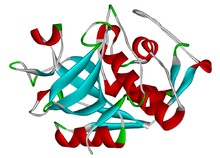Cathepsin
| Cathepsin | |||||||||
|---|---|---|---|---|---|---|---|---|---|

Structure of Cathepsin K
|
|||||||||
| Identifiers | |||||||||
| Symbol | CTP | ||||||||
| Pfam | PF00112 | ||||||||
| Pfam clan | CL0125 | ||||||||
| InterPro | IPR000668 | ||||||||
| SMART | Pept_C1 | ||||||||
| PROSITE | PDOC00126 | ||||||||
| MEROPS | C1 | ||||||||
| SCOP | 1aec | ||||||||
| SUPERFAMILY | 1aec | ||||||||
|
|||||||||
| Available protein structures: | |
|---|---|
| Pfam | structures |
| PDB | RCSB PDB; PDBe; PDBj |
| PDBsum | structure summary |
Cathepsins (Ancient Greek kata- "down" and hepsein "boil"; abbreviated CTS) are proteases (enzymes that degrade proteins) found in all animals as well as other organisms. There are approximately a dozen members of this family, which are distinguished by their structure, catalytic mechanism, and which proteins they cleave. Most of the members become activated at the low pH found in lysosomes. Thus, the activity of this family lies almost entirely within those organelles. There are, however, exceptions such as cathepsin K, which works extracellularly after secretion by osteoclasts in bone resorption.
Cathepsins have a vital role in mammalian cellular turnover, e.g. bone resorption. They degrade polypeptides and are distinguished by their substrate specificities.
Cathepsins have been implicated in:
B and L are involved in matrix degradation and cell invasion.
Deficiencies in this protein are linked to multiple forms of galactosialidosis. The cathepsin A activity in lysates of metastatic lesions of malignant melanoma is significantly higher than in primary focus lysates. Cathepsin A increased in muscles moderately affected by muscular dystrophy and denervating diseases.
Cathepsin B seems to cause amyloid plaque, the root of Alzheimer's symptoms, when there are wild-type beta-secretase present in the system Overexpression of the encoded protein, which is a member of the peptidase C1 family, has been associated with esophageal adenocarcinoma and other tumors. Cathepsin B has also been implicated in the progression of various human tumors including ovarian cancer.
Cathepsin D (an aspartyl protease) appears to cleave a variety of substrates such as fibronectin and laminin. Unlike some of the other cathepsins, cathepsin D has some protease activity at neutral pH. High levels of this enzyme in tumor cells seems to be associated with greater invasiveness.
...
Wikipedia
